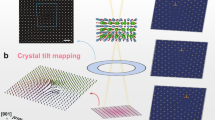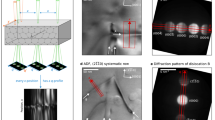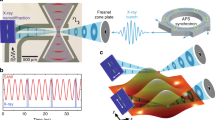Abstract
Defects and their associated long-range strain fields are of considerable importance in many areas of materials science1,2. For example, a major challenge facing the semiconductor industry is to understand the influence of defects on device operation, a task made difficult by the fact that their interactions with charge carriers can occur far from defect cores, where the influence of the defect is subtle and difficult to quantify3,4. The accurate measurement of strain around defects would therefore allow more detailed understanding of how strain fields affect small structures—in particular their electronic, mechanical and chemical properties—and how such fields are modified when confined to nanometre-sized volumes. Here we report the measurement of displacements around an edge dislocation in silicon using a combination of high-resolution electron microscopy and image analysis inherited from optical interferometry. The agreement of our observations with anisotropic elastic theory calculations is better than 0.03 Å. Indeed, the results can be considered as an experimental verification of anisotropic theory at the near-atomic scale. With the development of nanostructured materials and devices, we expect the use of electron microscopy as a metrological tool for strain analysis to become of increasing importance.
This is a preview of subscription content, access via your institution
Access options
Subscribe to this journal
Receive 51 print issues and online access
$199.00 per year
only $3.90 per issue
Buy this article
- Purchase on Springer Link
- Instant access to full article PDF
Prices may be subject to local taxes which are calculated during checkout




Similar content being viewed by others
References
Nabarro, F. R. N. (ed.) Dislocations in Solids Vols 1–11 (Amsterdam, North-Holland, 1979–2003)
Lépinoux, J., Mazière, D., Pontikis, V. & Saada, G. (eds) Multiscale Phenomena in Plasticity: From Experiments to Phenomenology, Modelling and Materials Engineering (NATO Science Series Applied Science Vol. 367, Kluwer Academic, Dordrecht, The Netherlands, 2000)
Semiconductor Industry Association The National Technology Road Map for Semiconductors at 〈http://public.itrs.net/〉 (2002).
Alexander, H. & Teichler, H. in Handbook of Semiconductor Technology (eds Jackson, K. A. & Schröter, W.) 293–376 (Wiley-VCH, Berlin, 2000)
Hÿtch, M. J. & Plamann, T. Reliable conditions for the measurement of displacement and strain from high resolution electron microscope images. Ultramicroscopy 87, 199–212 (2001)
Treacy, M. M. J., Gibson, J. M. & Howie, A. On elastic relaxation and long wavelength microstructures in spinodally decomposed InxGa1-xAsyP1-y epitaxial layers. Phil. Mag. A 51, 389–417 (1985)
Möbus, G. & Kienzle, O. Probability calculus for quantitative HREM. Ultramicroscopy 85, 183–198 (2000)
Jia, C. L. & Thust, A. Investigation of atomic displacements at a Σ3 {111} twin boundary in BaTiO3 by means of phase-retrieval electron microscopy. Phys. Rev. Lett. 82, 5052–5055 (1999)
Weirich, T. E., Ramlau, R., Simon, A., Hovmoller, S. & Zou, X. A crystal structure determined with 0.02 Å accuracy by electron microscopy. Nature 382, 144–146 (1996)
Hÿtch, M. J., Snoeck, E. & Kilaas, R. Quantitative measurement of displacement and strain fields from HREM micrographs. Ultramicroscopy 74, 131–146 (1998)
Hirth, J. P. & Lothe, J. Theory of Dislocations (McGraw-Hill, New York, 1968)
Bierwolf, R. et al. Direct measurement of local lattice distortions in strained layer structures by HREM. Ultramicroscopy 49, 273–285 (1993)
Takeda, M., Ina, H. & Kobayashi, S. Fourier-transform method of fringe pattern analysis for computer-based topography and interferometry. J. Opt. Soc. Am. 72, 156–160 (1982)
Takeda, M. & Suzuki, J. Crystallographic heterodyne phase detection for highly sensitive lattice-distortion measurements. J. Opt. Soc. Am. A 13, 1495–1500 (1996)
Gabor, D. Theory of communication. Proc. Inst. Electr. Eng. 93, 429–457 (1946)
Hÿtch, M. J. Analysis of variations in structure from high resolution electron microscope images by combining real space and Fourier space information. Microsc. Microanal. Microstruct. 8, 41–57 (1997)
Kret, S., Dluzewski, P., Dluzewski, P. & Sobczak, E. Measurement of dislocation core distribution by digital processing of high-resolution transmission electron microscopy micrographs: a new technique for studying defects. J. Phys. C 12, 10313–10318 (2000)
Thibault-Desseaux, J., Putaux, J. L., Bourret, A. & Kirchner, H. O. K. Dislocations stopped by the Σ9(122) grain boundary in Si. An HREM study of thermal activation. J. Phys. France 50, 2525–2540 (1989)
Acknowledgements
This work was carried out as part of a CNRS funded European network (GDR-E) “Quantification and measurement in transmission electron microscopy”, involving laboratories in France, the UK, Germany and Switzerland. M.J.H. would like to thank M. Nowak for help with the elastic theory calculations.
Author information
Authors and Affiliations
Corresponding author
Ethics declarations
Competing interests
The authors declare that they have no competing financial interests.
Rights and permissions
About this article
Cite this article
Hÿtch, M., Putaux, JL. & Pénisson, JM. Measurement of the displacement field of dislocations to 0.03 Å by electron microscopy. Nature 423, 270–273 (2003). https://doi.org/10.1038/nature01638
Received:
Accepted:
Issue Date:
DOI: https://doi.org/10.1038/nature01638
This article is cited by
-
Vertical nanoscale strain-induced electronic localization in epitaxial La2/3Sr1/3MnO3 films with ZrO2 nanopillar inclusions
Nano Convergence (2023)
-
Contribution of boundary non-stoichiometry to the lower-temperature plasticity in high-pressure sintered boron carbide
Nature Communications (2023)
-
Two-dimensional single crystal monoclinic gallium telluride on silicon substrate via transformation of epitaxial hexagonal phase
npj 2D Materials and Applications (2023)
-
Influence of the hierarchical architecture of multi-core iron oxide nanoflowers on their magnetic properties
Scientific Reports (2023)
-
Directly imaging of the atomic structure of luminescent centers in CaYAlO4:Ce3+
Nano Research (2023)
Comments
By submitting a comment you agree to abide by our Terms and Community Guidelines. If you find something abusive or that does not comply with our terms or guidelines please flag it as inappropriate.



